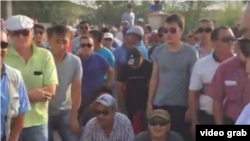
When the five independent countries of Central Asia emerged after the collapse of the Soviet Union in late 1991, the governments of Kazakhstan, Kyrgyzstan, Tajikistan Turkmenistan, and Uzbekistan were faced with a challenge -- creating a national identity.
For the most part it was not such a difficult task. The region has been inhabited for thousands of years and even the most recent arrivals among the titular peoples can trace their history back hundreds of years.
Still, there was an urgency for the five governments to invent a national character, one that was distinct from the colonial master since the 19th century (or earlier), Russia, and also distinct from one another.
To reinforce this sense of national identity, the authorities step in to provide rulings or interpretations of proper behavior, clothing, and, on occasions, entertainment.
RFE/RL's Uzbek Service, known locally as Ozodlik, has learned there is a ban on the use of a stringed instrument called a "tar," which literally translates as "string." Officials believe the tar is not part of the orchestration of traditional Uzbek music.
Verbal instructions have come "from above" that the tar is not to be seen in television programs or music videos. During the recent summit of the Shanghai Cooperation Organization in Tashkent, a concert given for the attending heads of state featured the Eshchonov brothers from Khorezm who usually play traditional Uzbek songs on the tar. The Eshchonovs appeared singing a traditional Uzbekistan song (while cameras showed President Islam Karimov dancing) but without the tars they usually play.
It turns out the tar is a foreign musical instrument. Many believe it is an Azerbaijani instrument, though Iran makes a claim to the stringed instrument being a purely Persian creation. Wherever the tar does come from, in the view of Uzbekistan's authorities it does not come from Uzbek culture, so no tars on television.
Ozodlik contacted an official at Uzbekistan's Ministry of Culture and Sports. Speaking under condition of anonymity, the official denied there was a ban on the tar. "No one has forbidden [playing the tar], it is simply that the tar is not on the list of our instruments," he said. The official explained that anyone could play the tar if they wished, "but they should remember the tar is not an Uzbek, but rather an Azerbaijani instrument."
Ozodlik contacted someone in the military band. Also under condition of anonymity, the armed forces musician said, "Command said that the tar is an Azerbaijani instrument...therefore we do not need it."
As the official from the Culture Ministry noted, there is no ban on playing the tar at home or, seemingly, at small local concerts or performance that will not be filmed. Music schools can no longer teach students how to play the tar but people are not forbidden from picking it up on their own.
And Ozodlik found out it's not only the tar that is "off the air." The accordion has also fallen into the category of "foreign" or "non-Uzbek" musical instruments. Again, people can play the accordion at home or at parties with friends, but accordions cannot be included in performances of Uzbek songs on television.
How far the authorities intend to go to enforce the use of only Uzbek instruments for playing Uzbek songs, or even all of what qualifies as a traditional Uzbek song is unclear (Look out Flyin' Up).
Ozodlik discovered some other new regulations outside the music world -- and don't ask us why, we don't make these rules.
From now on, television newscasters are forbidden from using hair dye. Also, women newscasters are not supposed to appear on air wearing an "adras" (look it up, you'll recognize it if you've been in Uzbekistan).






